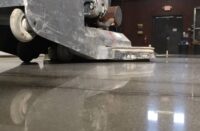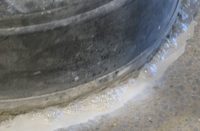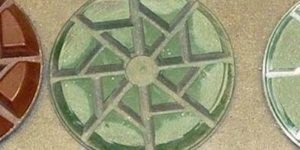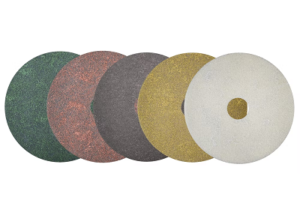The time has come to start asking detailed and educated questions when buying diamond tooling. While some features can be seen when looking at the segment, some things are not so obvious. However, purchasing diamond tooling can be simple when you become educated.
There are as many variables in manufacturing diamond tooling as there are diamond manufacturers. So which specific variables should you concern yourself with and why?
With this information and your experience, we can take a bit of the mystery out of buying diamonds.

Cometing
Cometing refers to the comet trails that are visible on the face of the diamond bond. You can glean from a visual inspection that the diamond bond has been opened at the factory.
The amount of cometing shows how rich or full the diamond bond is with diamonds. Manufacturers can lower the cost of a diamond bond segment by reducing the amount of diamonds. Less diamond grit means less cometing.
Cometing also signifies that the diamond bond has not glazed over, or closed, to a point where no grinding will be realized. Glazing occurs when diamonds get too hot and rub across the concrete instead of cutting or scratching. If you suspect your diamonds may not be cutting, stop and take a look at the surface of the diamonds. If you see very little cometing, chances are you are glazing. Change bonds, reverse the direction, or take them off and open them up by abrading the surface with sandpaper or a rough piece of unrefined concrete until the dark burn has been removed. Once the job is complete, clean that set of diamonds and evaluate. It just might be that there were not very many diamonds in that matrix to start with.
Diamond mesh size
Premium diamond manufacturers go to great lengths to filter their mesh or diamond grit size so only the desired grit is used. Filtering several times to ensure strict guidelines is time-consuming, but proper mesh or filtration ensures that a larger-grit diamond, better known as a “hangar diamond,” will not contaminate the bond matrix that could potentially produce a deep random scratch.
Concentration
With consistent grit throughout the bond matrix, as the diamond bond matrix wears, an even concentration of diamonds is exposed. This manufacturing process requires mixing or tumbling the diamonds with the bond matrix. Many manufacturers cut this process short to “save you money.”
Diamond ratio
Diamond ratio determines how effectively a diamond bond matrix will last and cut. For example, 30/40 grit will have a certain ratio of 30-grit to 40-grit diamonds. Mixing the grits keeps the diamond bond matrix open, allowing for a continuous and effective cut.
Quality diamonds
Diamonds used in metal-bond matrixes are either geologically mined or synthetically manufactured. The advantage of synthetic-made diamonds is their obvious lower cost. But more importantly, synthetic diamonds are manufactured to have a multitude of angles, giving the diamond a constant sharp edge, which helps to provide for a continuous cut into the substrate.
Historically, geologically mined diamonds were all we had. These diamond bits were remnants from cuts of retail diamonds. Taking additional time to cut angles into these diamonds would be cost-prohibitive. Hence, the solution of synthetic diamonds.
Bond matrix
Bond matrix is what determines if the floor will eat your diamonds or just be cut. So pay attention here. Developing just one bond matrix to handle every level of hardness is impossible. To process the floor efficiently, a soft bond should be used on hard concrete and a hard bond on soft concrete. When polishing is done right, maximum refinement will be achieved with the fewest rotations over the surface.
Each diamond tooling manufacturer designs and engineers their matrix using unique blends of elements: metal, resin, ceramics, etc. Wear and cut are dependent upon these recipes. The “very soft” bond is distinct from a “soft” bond matrix, and so on for each bond level.
The soft bond matrix will provide just enough wear to continuously expose new diamond points and angles, allowing continuous cutting. This becomes important when grinding very hard concrete, as high-quality premium diamonds that are solid and angular will be sharper and cut better. On the other hand, with soft concrete, a lower-grade diamond is preferred because it will continuously fracture and expose new sharp edges that will continue to cut the concrete. The manufacturer’s blend is correct when the tool life is sufficiently longer and it is still cutting and not glazing. Remember, comets are good!
Sintering
Sintering is creating objects from powders, and whether to do hot or cold sintering is an engineering decision. When done correctly, it creates a diamond bond that is solid and will not fracture nor fall apart.
I used to try to break a resin puck if I saw air holes, because that meant it might not have been sintered correctly. Heat and pressure during hot sintering is an exact science. Cold sintering uses pressure without heat and has its advantages and disadvantages like any other process.
I am sure you are getting the point by now that much goes into manufacturing a highly effective, long-lasting diamond segment. Knowing what to look for and what to ask makes you an informed consumer.
I would like to thank Ron Yagur of Dynamic Diamond Tooling for his technical help in writing this article.















